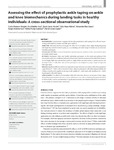Mostrar o rexistro simple do ítem
Assessing the effect of prophylactic ankle taping on ankle and knee biomechanics during landing tasks in healthy individuals: A cross-sectional observational study
| dc.contributor.author | Romero Morales, Carlos | |
| dc.contributor.author | Matilde-Cruz, Ana | |
| dc.contributor.author | García-Arrabe, María | |
| dc.contributor.author | Higes-Núñez, Félix | |
| dc.contributor.author | Días Lópes, Alexandre | |
| dc.contributor.author | Jiménez Saiz, Sergio | |
| dc.contributor.author | Pareja-Galeano, Helios | |
| dc.contributor.author | López-López, Daniel | |
| dc.date.accessioned | 2023-12-26T09:24:17Z | |
| dc.date.available | 2023-12-26T09:24:17Z | |
| dc.date.issued | 2023-07-31 | |
| dc.identifier.citation | Romero-Morales, C., Matilde-Cruz, A., García-Arrabe, M., Higes-Núñez, F., Lópes, A. D., Saiz, S. J., Pareja-Galeano, H., & López-López, D.. (2024). Assessing the effect of prophylactic ankle taping on ankle and knee biomechanics during landing tasks in healthy individuals: A cross-sectional observational study. Sao Paulo Medical Journal, 142(2), e2022548. https://doi.org/10.1590/1516-3180.2022.0548.R1.10032023 | es_ES |
| dc.identifier.uri | http://hdl.handle.net/2183/34619 | |
| dc.description.abstract | [Abstract] BACKGROUND: Current research supports the fact that prophylactic ankle taping (AT) is effective in preventing ankle injuries in amateur and elite sports athletes. OBJECTIVE: This study aimed to investigate the effect of AT on balance, knee valgus during drop jump and single-leg countermovement jump (SL-CMJ) landings, and ankle range of motion (ROM) restriction in healthy participants. DESIGN AND SETTING: A cross-sectional observational study was conducted at the Universidad Europea de Madrid, Madrid, Spain. METHODS: Participants: Thirty-nine healthy individuals participated in this study and performed the movements under two conditions (with and without tape). Outcome measurements: ankle ROM, balance, SL-CMJ height, flight time, ground time, and knee valgus. Before any intervention, a random process was developed with a 1:1 allocation ratio, and the participants were assigned to groups A (tape-no tape) and B (no tape-tape). RESULTS: Significant differences between tape and no-tape moments were observed for drop jump knee valgus flexion (P = 0.007), with an increase in knee valgus in participants with ankle taping. Similarly, the Y-balance testshowed a significant decrease in all variables (P = 0.001 and), ankle dorsiflexion (P = 0.001) in participants with ankle taping. CONCLUSIONS: AT is effective for immediate ankle ROM restriction. However, an increase in knee valgus during drop jump task and a decrease in lower limb balance were observed during drop jump task. Based on these results, it can be concluded that AT application in healthy individuals should not be recommended as it results in increase in injury risk factors. | es_ES |
| dc.description.sponsorship | Cátedra Fisioclub & Sports; CAT002102 | es_ES |
| dc.language.iso | eng | es_ES |
| dc.publisher | Scielo | es_ES |
| dc.relation.uri | https://doi.org/10.1590/1516-3180.2022.0548.R1.10032023 | es_ES |
| dc.rights | Atribución 3.0 España | es_ES |
| dc.rights.uri | http://creativecommons.org/licenses/by/3.0/es/ | * |
| dc.subject | Ankle injuries | es_ES |
| dc.subject | Biomechanical phenomena | es_ES |
| dc.subject | Kinetics | es_ES |
| dc.subject | Hopping training | es_ES |
| dc.subject | Kinematics | es_ES |
| dc.subject | Biomechanics | es_ES |
| dc.subject | Lesiones en el tobillo | es_ES |
| dc.subject | Fenómenos biomecánicos | es_ES |
| dc.subject | Cinética | es_ES |
| dc.subject | Entrenamiento de salto | es_ES |
| dc.subject | Cinemática | es_ES |
| dc.subject | Biomecánica | es_ES |
| dc.title | Assessing the effect of prophylactic ankle taping on ankle and knee biomechanics during landing tasks in healthy individuals: A cross-sectional observational study | es_ES |
| dc.type | info:eu-repo/semantics/article | es_ES |
| dc.rights.access | info:eu-repo/semantics/openAccess | es_ES |
| UDC.journalTitle | Sao Paulo Medical Journal | es_ES |
| UDC.volume | 142 | es_ES |
| UDC.issue | 3 | es_ES |
| UDC.startPage | e2022548 | es_ES |
Ficheiros no ítem
Este ítem aparece na(s) seguinte(s) colección(s)
-
GI-UDISAP - Artigos [194]






